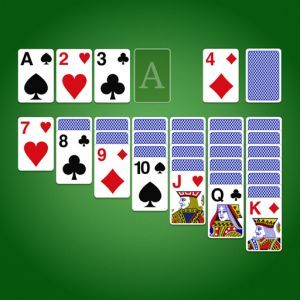
Rate the Game:
Android
Jun 21, 2023
54.53 MB
3.10.0-23060677
Guru Smart Holding Limited
Casual
IOS
Jun 12, 2023
185.3 MB
3.10.0
Guru Smart Holding Limited
Casual
Advertisement
Solitaire: Classic Card Games is a timeless and addictive mobile game that brings the popular solitaire card game to your fingertips. With its simple yet engaging gameplay, stunning visuals, and a variety of challenging game modes, Solitaire provides endless hours of entertainment. Let's delve into the game's introduction and explore the most attractive features that keep players coming back for more.
Solitaire is a single-player card game that has been enjoyed by millions of players worldwide for generations. The objective of the game is to arrange all the cards in a specific order according to their suits and ranks. The game features a deck of 52 cards, and players must strategically move cards between different columns and foundations to complete the game successfully.
Solitaire: Classic Card Games stays true to the traditional rules and mechanics of the classic solitaire game. Players must arrange cards in descending order while alternating between red and black suits. This familiarity and simplicity make the game easy to pick up for both experienced solitaire players and newcomers.
The game offers a variety of game modes to cater to different preferences and skill levels. Players can choose from classic Klondike, Spider, FreeCell, Pyramid, and many other exciting variations. Each game mode presents its own set of challenges and strategies, ensuring that players always have a fresh and engaging experience.
Solitaire: Classic Card Games features stunning visuals and captivating themes that enhance the gaming experience. Players can customize the look and feel of their game with a range of visually appealing card designs, backgrounds, and animations. The attractive graphics create an immersive environment that keeps players visually engaged throughout their gameplay.
The game offers daily challenges that provide additional excitement and rewards. These challenges often have specific objectives or constraints, challenging players to think strategically and find optimal solutions. Completing daily challenges rewards players with in-game currency, power-ups, or other bonuses, adding a sense of achievement and progression.
Solitaire: Classic Card Games includes leaderboards and social integration features that allow players to compete with friends or players from around the world. Players can compare their scores and achievements, participate in weekly or monthly tournaments, and strive to reach the top of the rankings. This social aspect adds a competitive element and fosters a sense of community within the game.
The game provides a range of customization options to personalize the playing experience. Players can customize the game's appearance, choose different card styles, backgrounds, and even select their preferred game rules and difficulty levels. This level of customization allows players to tailor the game to their preferences and create a personalized gaming environment.
Solitaire: Classic Card Games offers helpful features such as the undo and hint functions. The undo feature allows players to revert their moves and rethink their strategies, while the hint function provides guidance on the next best move. These features are especially useful for beginners or when players get stuck, ensuring that the game remains accessible and enjoyable for players of all skill levels.
Solitaire: Classic Card Games can be played offline, making it a perfect companion for players on the go. Whether you're commuting, traveling, or simply looking for a quick game to pass the time, Solitaire can be enjoyed anytime and anywhere without the need for an internet connection.
Solitaire: Classic Card Games combines the nostalgic charm of the traditional card game with modern features and customization options, creating an irresistible gaming experience. With its classic gameplay, stunning visuals, multiple game modes, and social integration, Solitaire keeps players engaged and entertained for hours on end. It's the perfect game for those who appreciate the simplicity, challenge,
Let's delve into the gameplay mechanics and explore the most difficult part of the game that players may encounter.
The objective of Solitaire is to arrange all the cards into their respective foundation piles in ascending order. Players can move cards between columns on the tableau, following the rule of alternating colors and descending ranks. Understanding and mastering the various card movement options, such as moving single cards, organizing sequences, and utilizing empty tableau slots, is crucial for success.
To win a game of Solitaire, players must build foundation piles for each suit, starting from the Ace and ascending to the King. Managing the placement of cards in the foundation piles requires careful planning and sequencing. Players need to consider which cards to prioritize for foundation building and which cards to keep available for tableau manipulation.
The tableau consists of several columns where cards are initially dealt. Players can move cards within the tableau columns and build descending sequences. Strategic decisions must be made when uncovering hidden cards or moving sequences, as these moves can either open up new opportunities or create potential roadblocks for future card placements.
When players run out of moves in the tableau, they can deal cards from the stock pile. However, this option should be used sparingly, as the number of cards in the stock is limited. Timing the use of stock cards and considering the potential impact on the game's progression is an important strategic aspect of Solitaire.
In some variations of Solitaire, players are challenged by time limits or move constraints. These additional elements add an extra layer of difficulty, requiring players to think quickly and efficiently. Managing time or move constraints effectively while still planning ahead and making optimal decisions can be particularly challenging.
The most difficult part of Solitaire is often found in the later stages of the game when players encounter complex card layouts and limited options for movement. Here are some challenges players may face:
As the game progresses, certain key cards may become buried beneath other cards in the tableau. Reaching these cards and incorporating them into the foundation piles can be challenging, requiring careful planning and strategic moves to clear the way.
Maintaining a clear and organized tableau becomes more challenging as the game progresses. Creating and managing sequences while keeping empty tableau slots for maneuverability is crucial. Deciding when to break existing sequences or when to leave an empty slot for future card placement can be a difficult strategic choice.
Solitaire requires players to make optimal moves and avoid unnecessary ones that may hinder progress. Analyzing the consequences of each move, evaluating different options, and predicting the impact on future card placements can be demanding. Choosing the right move among several viable possibilities becomes crucial for successful gameplay.
Some Solitaire variations involve multiple suits or unique rules, adding complexity to the game. Players must adapt to these variations and develop new strategies accordingly. Understanding the nuances of different game modes and adjusting one's gameplay approach can present an additional challenge.
To overcome these challenges, players need to maintain a balance between long-term planning and adaptability. Careful card manipulation, strategic sequencing, and efficient use of available moves are key to succeeding in Solitaire and achieving high scores.
Despite its seemingly simple rules, Solitaire: Classic Card Games provides a satisfying challenge that tests players' decision-making skills and ability to strategize. It's a game that rewards patience, observation, and careful planning, making each victory all the more rewarding.
Advertisement

1 2 3 4 Player Games - Offline

Football Strike: Online Soccer

Mindustry

Bouncemasters: Penguin Games

Survival Game Master

Incredibox

Power Slap

Collision Race

Candy Crush Soda Saga

Brainrot Line Breakout

Crossy Road

Friday Night Funkin'

Magic Dancing Tiles

Tap Color Pro: Color By Number

Fishing Master

Crazy Office — Slap & Smash










Advertisement